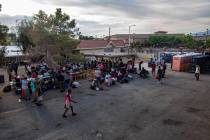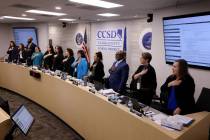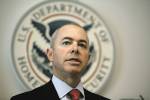Deadly force: Training, transparency can reduce police shootings
Police possess extraordinary powers in our free society. Officers must have the public's trust to do their jobs effectively and maintain a community's safety. No single law enforcement action tests that trust more than the killing of a suspect.
A yearlong investigation by the Las Vegas Review-Journal found the overwhelming majority of Southern Nevada's police shootings -- 378 since 1990, resulting in 142 deaths -- involved an indisputable, immediate threat to life, including dozens of instances in which officers were fired upon or had a gun pointed at them. These officers carried out their duties as any reasonable person would expect them to.
But the review also found serious shortcomings at Clark County police departments -- especially within the Las Vegas Metropolitan Police Department -- in how authorities handle incidents of deadly force. (The series can be found at www.lvrj.com/deadlyforce.)
The analysis determined that Las Vegas officers shoot more than their peers in many other urban departments, and that many shootings result from officers needlessly putting themselves in harm's way. In some cases, their actions would violate policies used in other cities that have not made it into the Las Vegas manual. And even when they violate department policies, officers are likely to get a pass from administrators unwilling to acknowledge errors.
In addition, the system all but ensures that problem cops may remain on the job, because formal reviews of deadly force incidents lack outside checks and balances, and as a result they consistently determine police killings are justified.
That makes it all the more important for police departments to train officers in proper use-of-force techniques, monitor their work and find ways to weed out the bad cops who can poison entire squads.
The investigation found that 75 Southern Nevada officers accounted for 30 percent of the shootings, and that police who've fired their guns sometimes have a record of problem behavior or go on to play a role in future police controversies. Indeed, a 2008 study of the New York Police Department found that officers with the most negative marks were three times more likely to have been in a shooting.
"Any time there's a controversial incident, look at that officer's history," Samuel Walker, professor at the University of Nebraska, Omaha, told the Review-Journal. "Historically, the dirty little secret in policing is that police know who the problem officers are."
Getting rid of them is the hard part. Former Las Vegas officer George "Gregg" Pease killed three men in the 1990s in separate controversial confrontations that had no witnesses. But all were unanimously ruled justified by coroner's inquests, and Pease kept his job.
The Clark County sheriff has wide authority to fire officers and can overturn advisory Use of Force Review Board rulings. But because of collective bargaining, officers can appeal their terminations. An arbitrator is not likely to side with the sheriff if both a civilian coroner's jury and a department review board have already cleared the officer. In addition, administrators fear firing an officer under such circumstances amounts to an admission of wrongdoing, thereby exposing the department to greater liability in civil lawsuits.
As a result, police administrators steadfastly refuse to fire officers over fatal shootings. Instead, they seek to get rid of bad cops over far less serious mistakes. Pease, for example, was disciplined for having sex with a prostitute, threatening her and trying to cover it up; disciplined again on allegations that he solicited sexual favors from women during traffic stops; and investigated on suspicion of misusing a department gas card. Pease finally quit in 2004.
In 2003, Las Vegas officer Brian Hartman fatally shot Orlando Barlow in the back when the suspect was unarmed and on his knees. Yet official reviews cleared Hartman, so he wasn't fired -- even after he and his squad made T-shirts celebrating the killing. Like Pease, he was compelled to quit.
Even Las Vegas Detective Bryan Yant, whose fatal shooting of kneeling, unarmed, small-time drug dealer Trevon Cole in 2010 spurred community outrage, wasn't fired for the sloppy police work that led to the raid on Mr. Cole's apartment. The shooting was unanimously ruled justified by a coroner's inquest and upheld by the Use of Force Review Board. For that killing -- Mr. Yant's second -- the policeman was demoted to a desk job and suspended for a week without pay.
Citizens need to know that authorities treat such fatalities as seriously as every other homicide they investigate and prosecute. They need to know whether the use of deadly force was proper. They need to know that any officer who violates department policies will be held accountable, and that safeguards are in place to protect both officers and the public during the most dangerous moments of police work.
Sheriff Doug Gillespie didn't create these problems. But leadership demands that he address them to reduce shootings. More rigorous training would help, as would a transparent, outside review process that isn't a rubber stamp. Department findings and discipline must not be kept secret.
But the sheriff also must more aggressively confront problem officers and use his bully pulpit to call out their union if it insists on protecting the worst of the worst.























